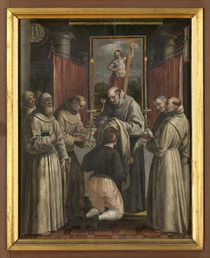The Catholic Defender: Saint Boniface
- Donald Hartley

- Jun 4
- 3 min read
Updated: Jun 6
Deepertruth with special permission and aid with Franiciscan Media, a great team for the Lord

Boniface, who was baptized Winfrid, lived in the eighth century. He was a brilliant monk in a Benedictine monastery in England. He was the head of a school, but he thought God wanted him to be a missionary. He went to Frisia (Northern Netherlands and Germany) to begin his work.
Boniface is known as the “Apostle of Germany” for his tremendous missionary efforts spreading the faith through that region of Europe during the Dark Ages. He was born in England in 680, and baptized with the name Winfrid. At the age of 5, he had his first encounter with educated monks when several visited his home.
Boniface, known as the apostle of the Germans, was an English Benedictine monk who gave up being elected abbot to devote his life to the conversion of the Germanic tribes. Two characteristics stand out: his Christian orthodoxy and his fidelity to the pope of Rome.
How absolutely necessary this orthodoxy and fidelity were is borne out by the conditions Boniface found on his first missionary journey in 719 at the request of Pope Gregory II. Paganism was a way of life. What Christianity he did find had either lapsed into paganism or was mixed with error. The clergy were mainly responsible for these latter conditions since they were in many instances uneducated, lax and questionably obedient to their bishops. In particular instances their very ordinations were questionable.

According to his early biographer Willibald, Boniface started to chop the oak down, when suddenly a great wind, as if by miracle, blew the ancient oak over. When the gods did not strike him down, the people were amazed and converted to Christianity.
A depiction of Boniface destroying Thor's oak from The Little Lives of the Saints (1904), illustrated by Charles Robinson.
These are the conditions that Boniface was to report in 722 on his first return visit to Rome. The Holy Father instructed him to reform the German Church. The pope sent letters of recommendation to religious and civil leaders. Boniface later admitted that his work would have been unsuccessful, from a human viewpoint, without a letter of safe-conduct from Charles Martel, the powerful Frankish ruler, grandfather of Charlemagne. Boniface was finally made a regional bishop and authorized to organize the whole German Church. He was eminently successful.
In the Frankish kingdom, he met great problems because of lay interference in bishops’ elections, the worldliness of the clergy and lack of papal control.
During a final mission to the Frisians, Boniface and 53 companions were massacred while he was preparing converts for confirmation.
In order to restore the Germanic Church to its fidelity to Rome and to convert the pagans, Boniface had been guided by two principles. The first was to restore the obedience of the clergy to their bishops in union with the pope of Rome. The second was the establishment of many houses of prayer which took the form of Benedictine monasteries. A great number of Anglo-Saxon monks and nuns followed him to the continent, where he introduced the Benedictine nuns to the active apostolate of education.
St. Boniface, deemed the “apostle to the Germans,” is regarded as the patron saint of brewers and tailors, as well as of Germany.
Saint Boniface of Tarsus (Greek: Βονιφάτιος) was, according to legend, executed for being a Christian in the year 307 at Tarsus, where he had gone from Rome in order to bring back to his mistress Aglaida (also written Aglaia) relics of the martyrs.
Boniface bears out the Christian rule: To follow Christ is to follow the way of the cross. For Boniface, it was not only physical suffering or death, but the painful, thankless, bewildering task of Church reform. Missionary glory is often thought of in terms of bringing new persons to Christ. It seems—but is not—less glorious to heal the household of the faith.





















Comments